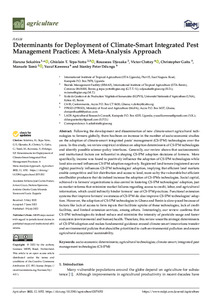| dc.contributor.author | Sekabira, H. |
| dc.contributor.author | Tepa-Yotto, G. |
| dc.contributor.author | Djouaka, R.F. |
| dc.contributor.author | Clottey, V. |
| dc.contributor.author | Gaitu, C. |
| dc.contributor.author | Tamo, M. |
| dc.contributor.author | Kaweesa, Y. |
| dc.contributor.author | Ddungu, S.P. |
| dc.date.accessioned | 2023-01-23T08:46:16Z |
| dc.date.available | 2023-01-23T08:46:16Z |
| dc.date.issued | 2022-07-19 |
| dc.identifier.citation | Sekabira, H., Tepa-Yotto, G., Djouaka, R., Clottey, V., Gaitu, C., Tamò, M., ... & Ddungu, S.P. (2022). Determinants for deployment of climate-smart integrated pest management practices: a meta-analysis approach. Agriculture, 12(7), 1-19. |
| dc.identifier.issn | 2077-0472 |
| dc.identifier.uri | https://hdl.handle.net/20.500.12478/8013 |
| dc.description.abstract | Following the development and dissemination of new climate-smart agricultural technologies to farmers globally, there has been an increase in the number of socio-economic studies on the adoption of climate-smart integrated pests’ management (CS-IPM) technologies over the years. In this study, we review empirical evidence on adoption determinants of CS-IPM technologies and identify possible science-policy interfaces. Generally, our review shows that socioeconomic and institutional factors are influential in shaping CS-IPM adoption decisions of farmers. More specifically, income was found to positively influence the adoption of CS-IPM technologies while land size owned influences CS-IPM adoption negatively. Registered land tenure (registered secure rights) positively influences CS-IPM technologies’ adoption, implying that efficient land markets that enable competitive and fair distribution and access to land, more so by the vulnerable but efficient smallholder producers do indeed increase the adoption of CS-IPMs technologies. Social capital, achieved via farmers’ organizations is also central in fostering CS-IPM technologies’ adoption, just as markets reforms that minimize market failures regarding access to credit, labor, and agricultural information, which could indirectly hinder farmers’ use of CS-IPM practices. Functional extension systems that improve farmers’ awareness of CS-IPM do also improve CS-IPM technologies’ adoption. However, the adoption of CS-IPM technologies in Ghana and Benin is slow-paced because of factors like lack of access to farm inputs that facilitate uptake of these technologies, lack of credit facilities, and limited extension services among others. Interestingly, our review confirms that CS-IPM technologies do indeed reduce and minimize the intensity of pesticide usage and foster ecosystem (environmental and human) health. Therefore, this review unearths strategic determinants of CS-IPM adoption and makes fundamental guidance around climate-smart innovations transfer and environmental policies that should be prioritized to curb environmental pollution and ensure agricultural ecosystems’ sustainability. |
| dc.description.sponsorship | World Bank |
| dc.description.sponsorship | Accelerating Impacts of CGIAR Climate Research for Africa |
| dc.format.extent | 1-19 |
| dc.language.iso | en |
| dc.subject | Climate Smart Agriculture |
| dc.subject | Socioeconomic Aspects |
| dc.subject | Agricultural Technology |
| dc.subject | Integrated Pest Management |
| dc.title | Determinants for deployment of climate-smart integrated pest management practices: a meta-analysis approach |
| dc.type | Journal Article |
| cg.contributor.crp | Grain Legumes |
| cg.contributor.affiliation | International Institute of Tropical Agriculture |
| cg.contributor.affiliation | Université Nationale d’Agriculture, Bénin |
| cg.contributor.affiliation | Centre for Agriculture and Bioscience International |
| cg.contributor.affiliation | Ministry of Food and Agriculture, Ghana |
| cg.contributor.affiliation | LADS Agricultural Research Consult, Uganda |
| cg.coverage.region | Africa |
| cg.coverage.region | Asia |
| cg.coverage.region | West Africa |
| cg.coverage.country | Benin (Dahomey) |
| cg.coverage.country | Ghana |
| cg.coverage.hub | Headquarters and Western Africa Hub |
| cg.researchtheme | Biotech and Plant Breeding |
| cg.researchtheme | Nutrition and Human Health |
| cg.researchtheme | Plant Production and Health |
| cg.identifier.bibtexciteid | SEKABIRA:2022 |
| cg.isijournal | ISI Journal |
| cg.authorship.types | CGIAR and developing country institute |
| cg.iitasubject | Agronomy |
| cg.iitasubject | Climate Change |
| cg.iitasubject | Food Security |
| cg.iitasubject | Plant Breeding |
| cg.iitasubject | Plant Production |
| cg.iitasubject | Socioeconomy |
| cg.journal | Agriculture |
| cg.notes | Open Access Journal; Published online: 19 Jul 2022 |
| cg.accessibilitystatus | Open Access |
| cg.reviewstatus | Peer Review |
| cg.usagerightslicense | Creative Commons Attribution 4.0 (CC BY 0.0) |
| cg.targetaudience | Scientists |
| cg.identifier.doi | https://dx.doi.org/10.3390/agriculture12071052 |
| cg.iitaauthor.identifier | HARUNA SEKABIRA: 0000-0001-5675-7211 |
| cg.iitaauthor.identifier | Ghislain Tepa-Yotto: 0000-0002-9650-8313 |
| cg.iitaauthor.identifier | Victor Attuquaye Clottey: 0000-0002-1455-5731 |
| cg.iitaauthor.identifier | Manuele Tamò: 0000-0002-5863-7421 |
| cg.futureupdate.required | No |
| cg.identifier.issue | 7 |
| cg.identifier.volume | 12 |

